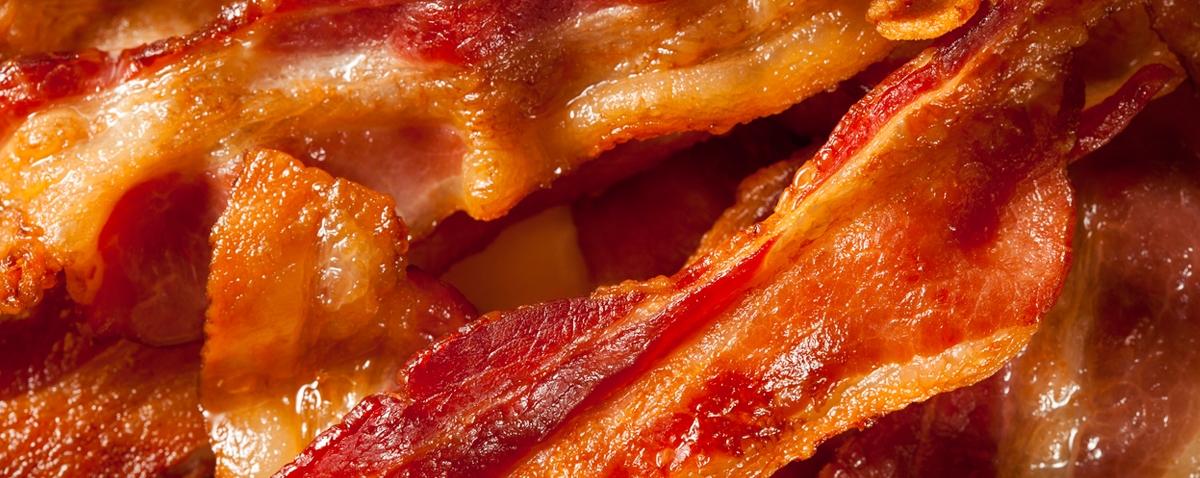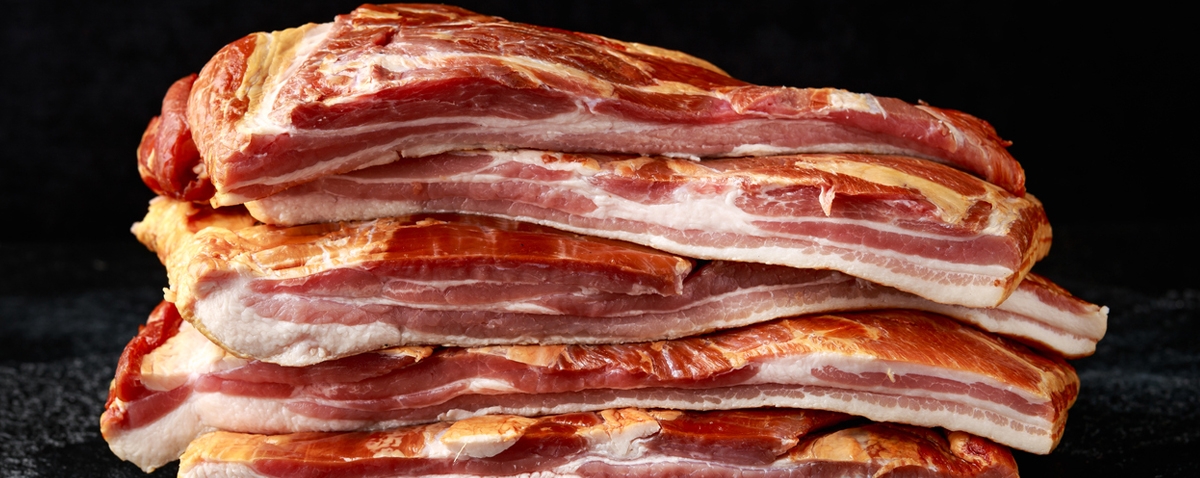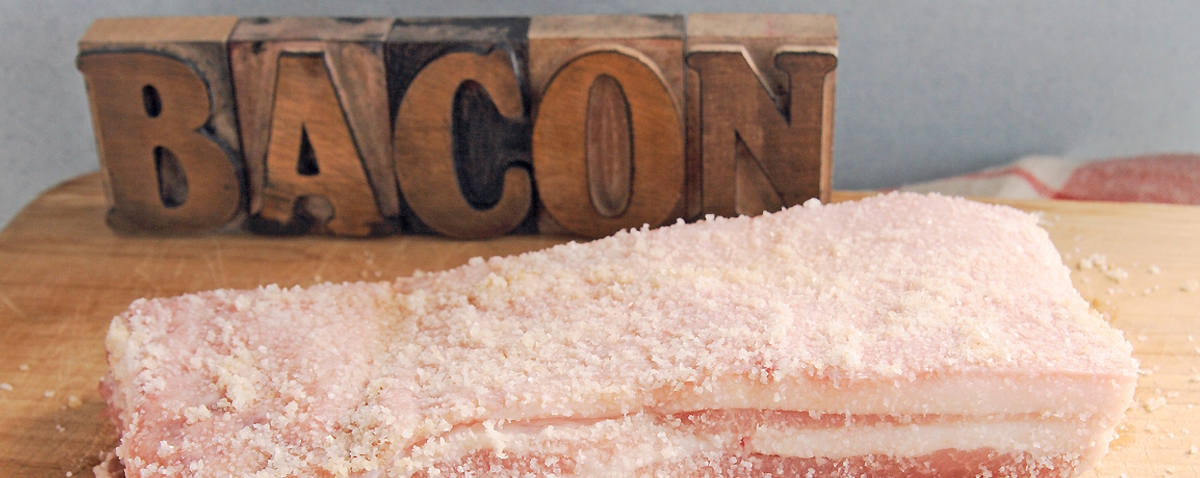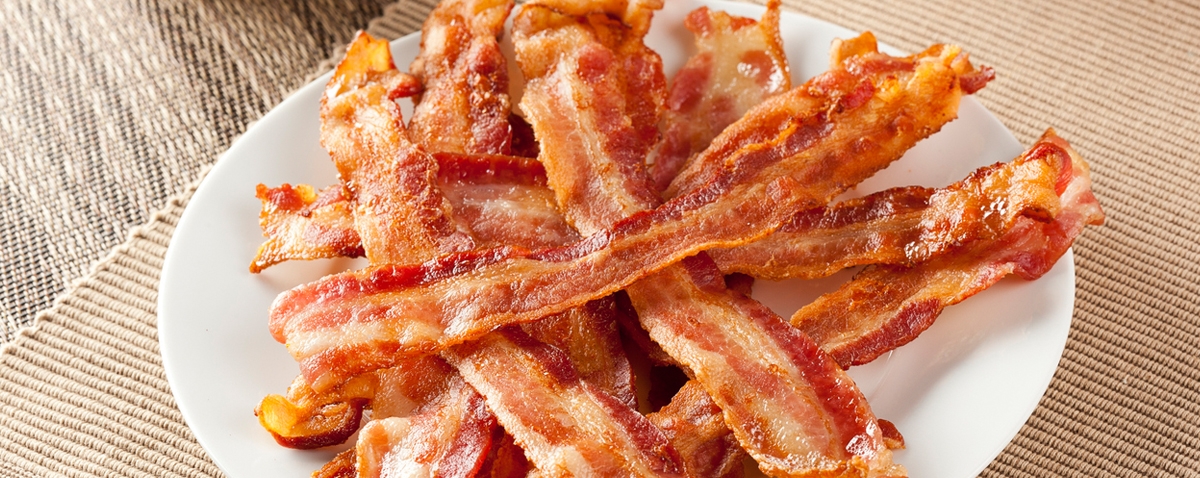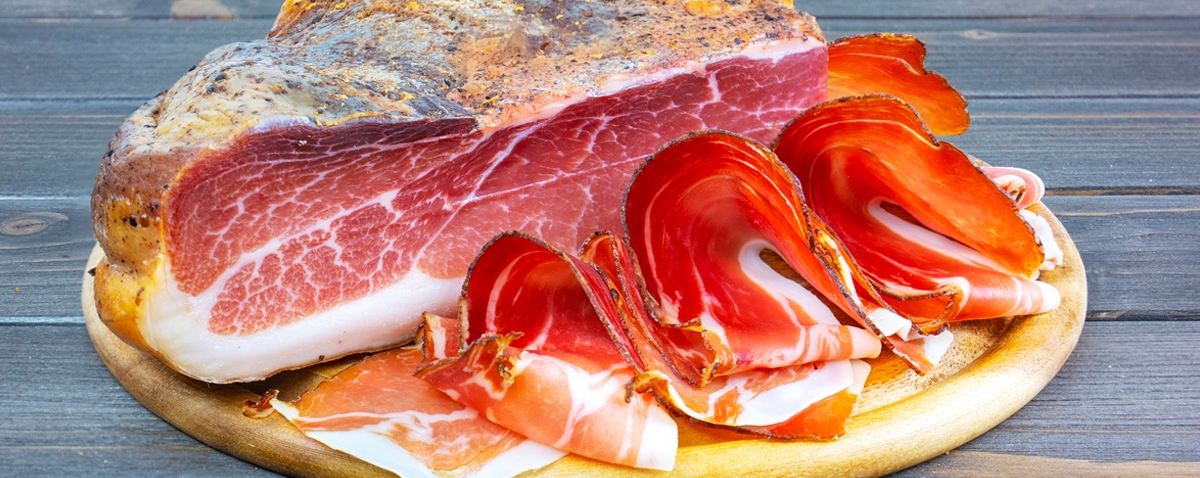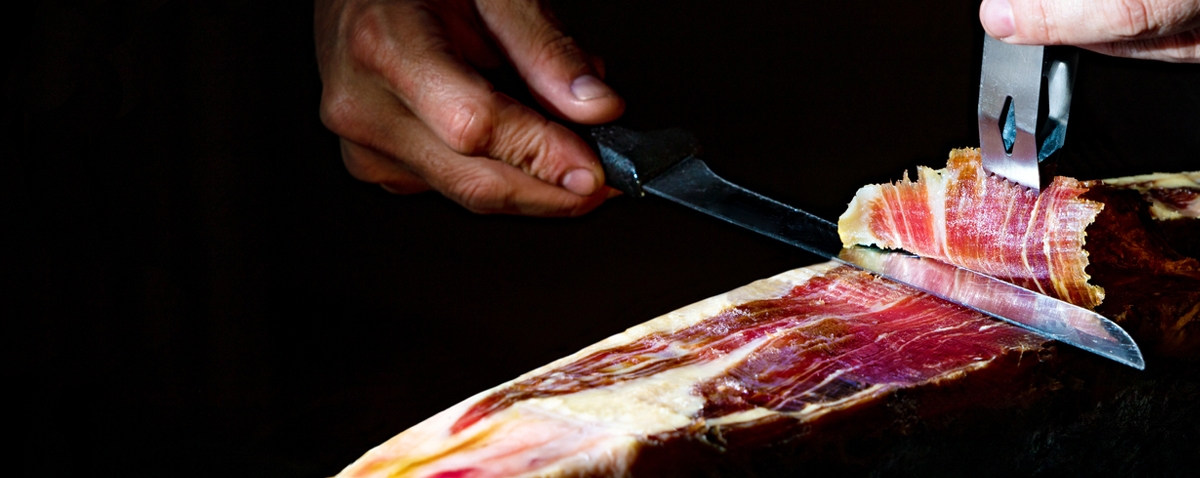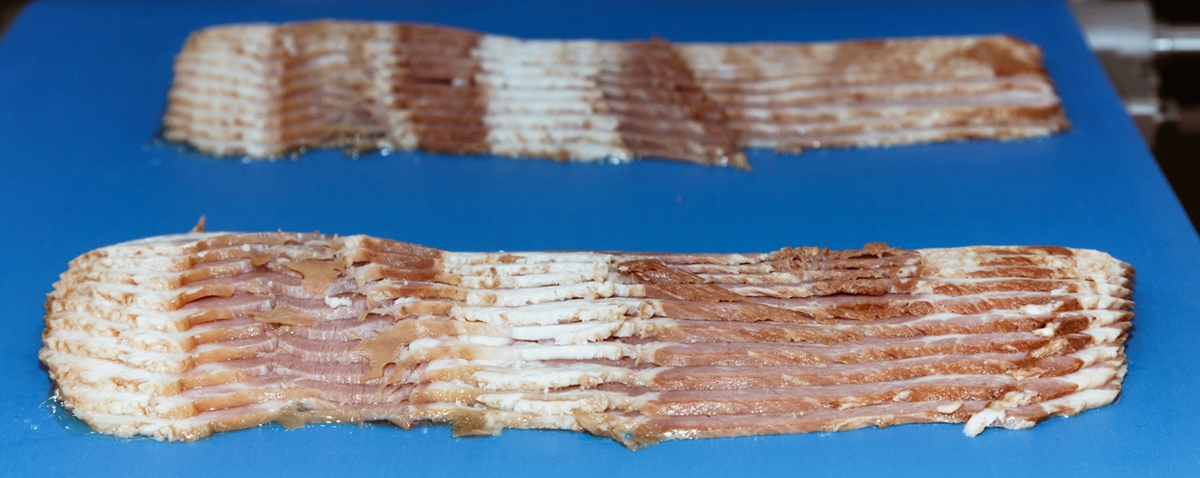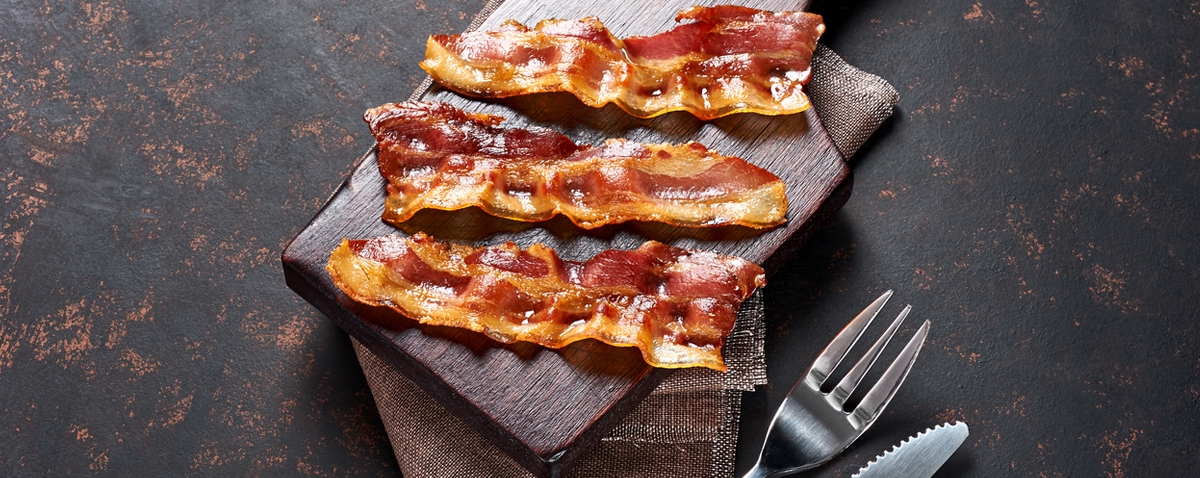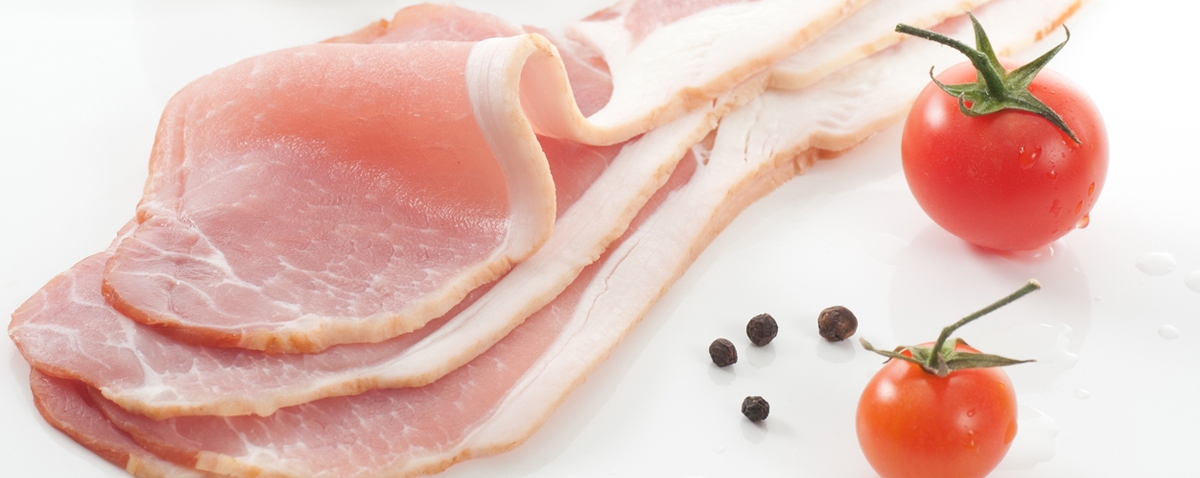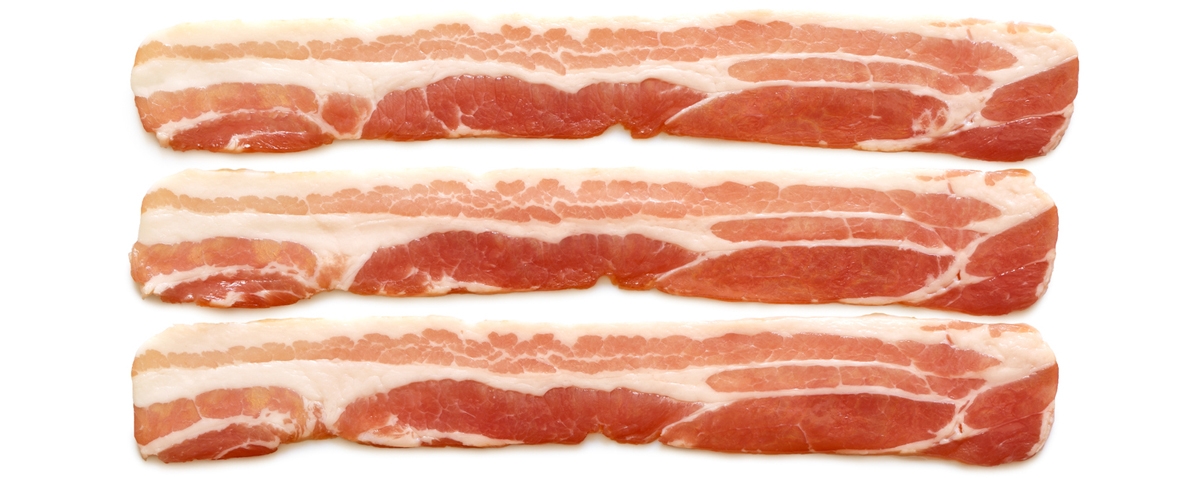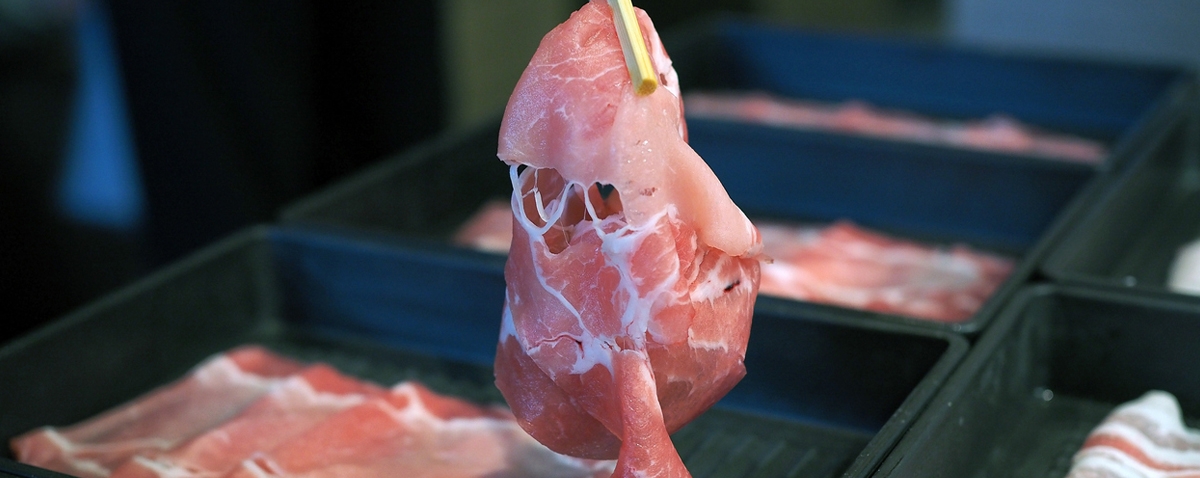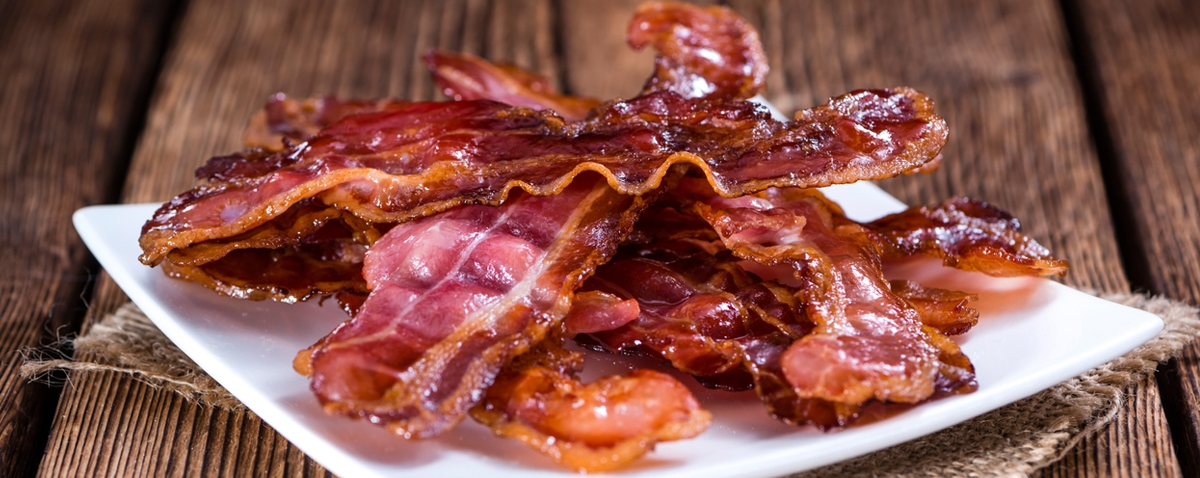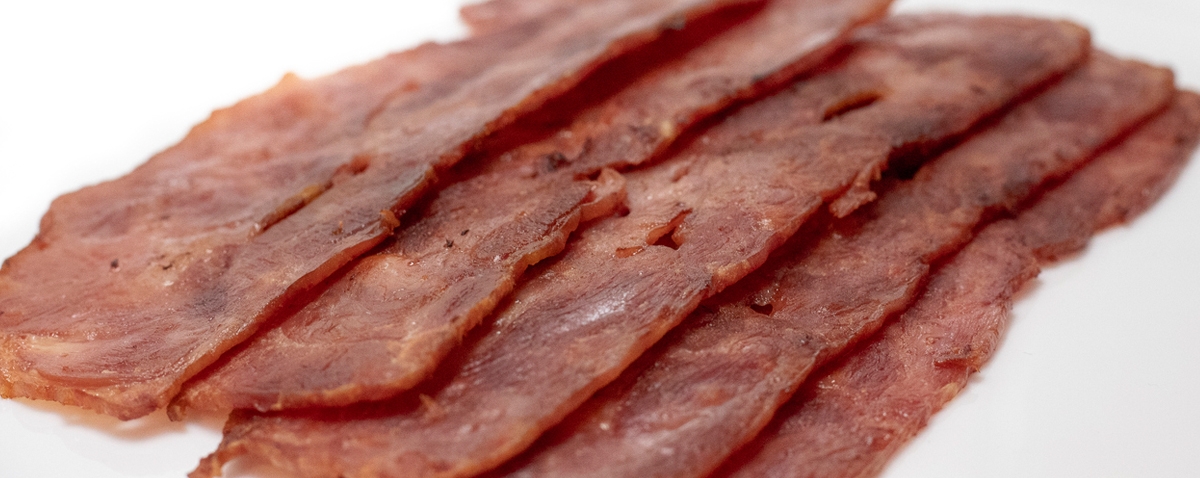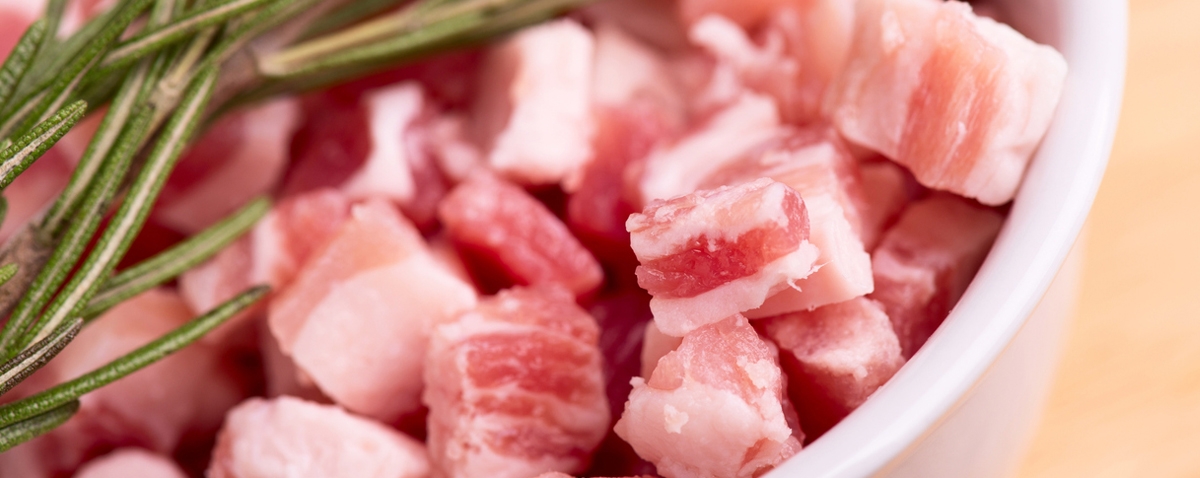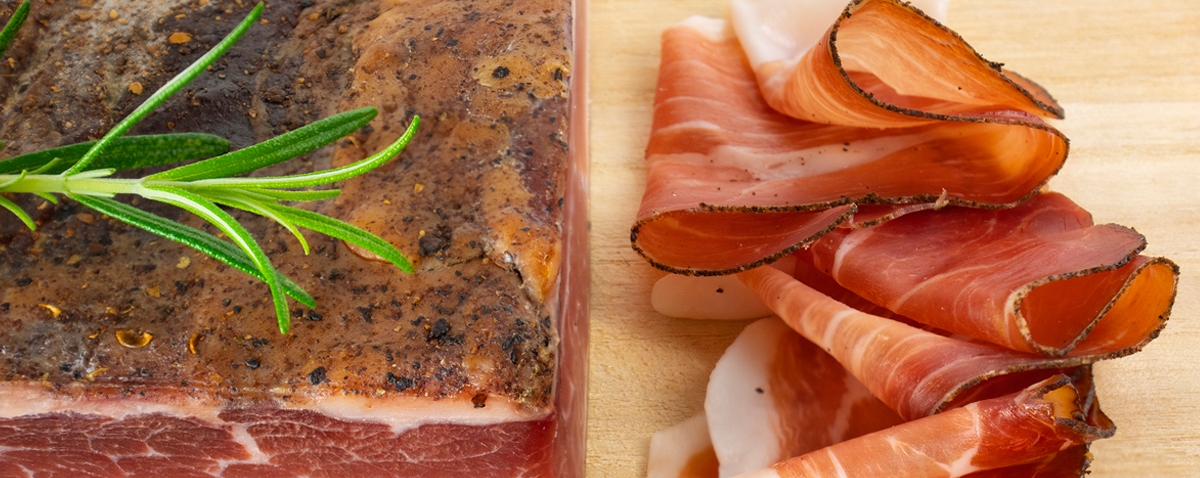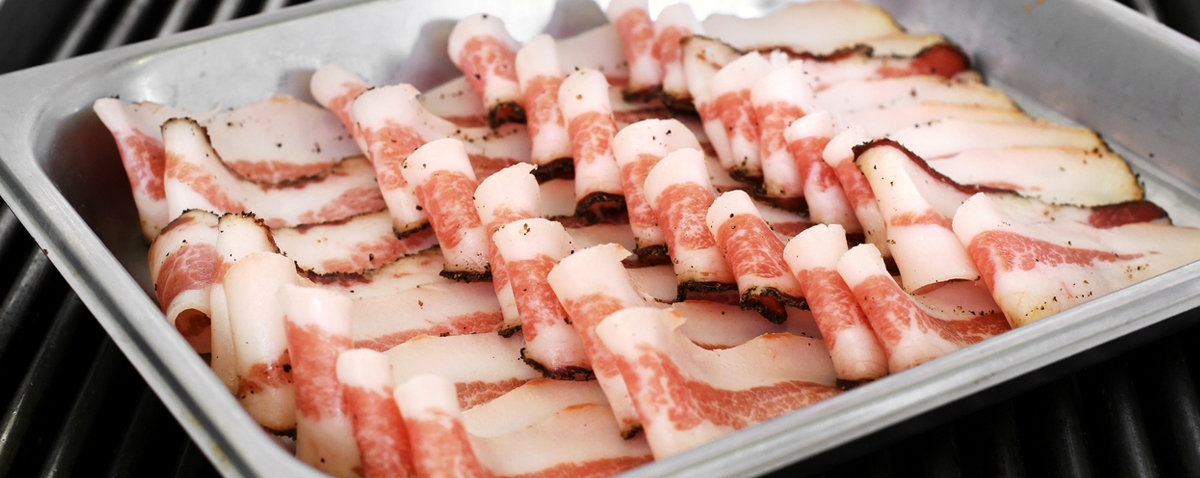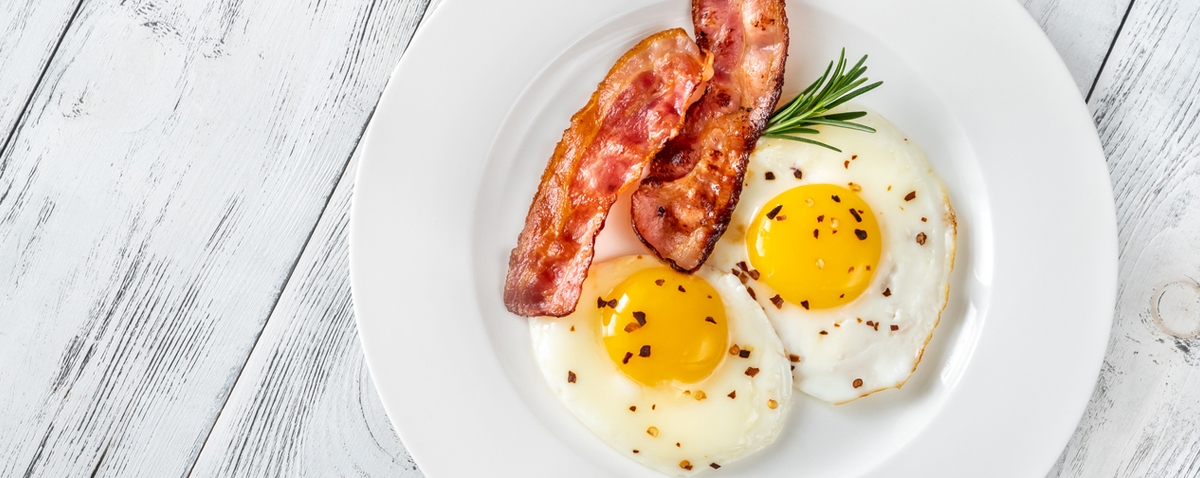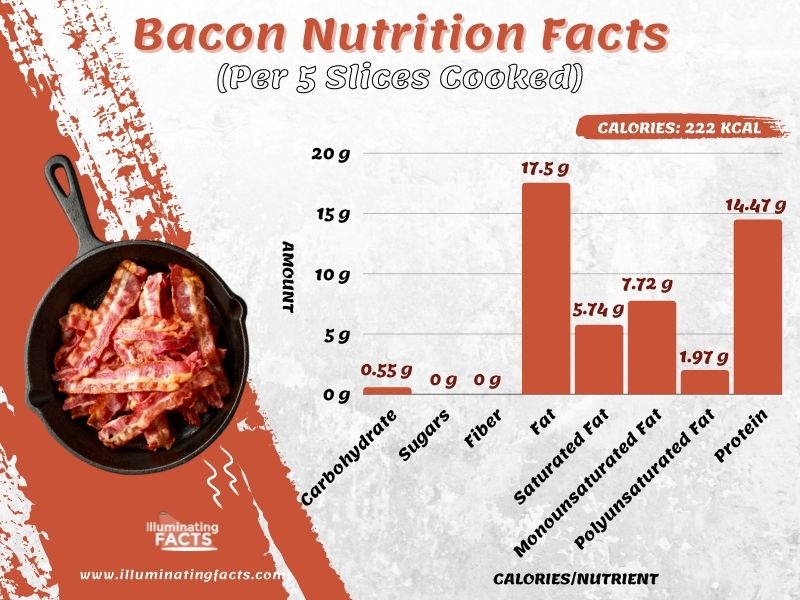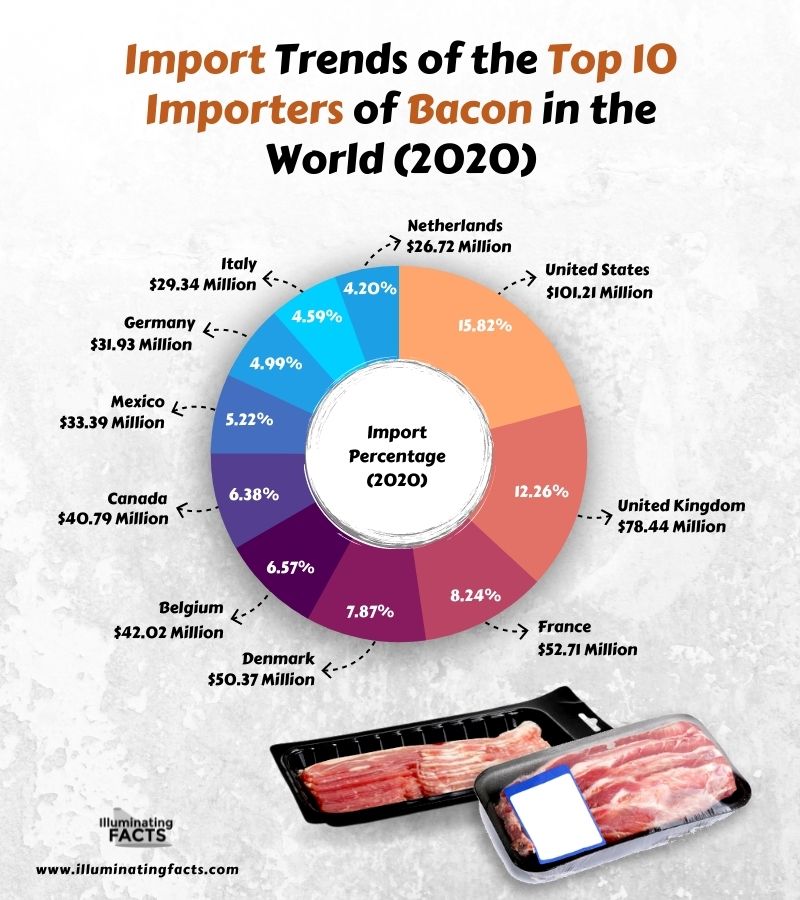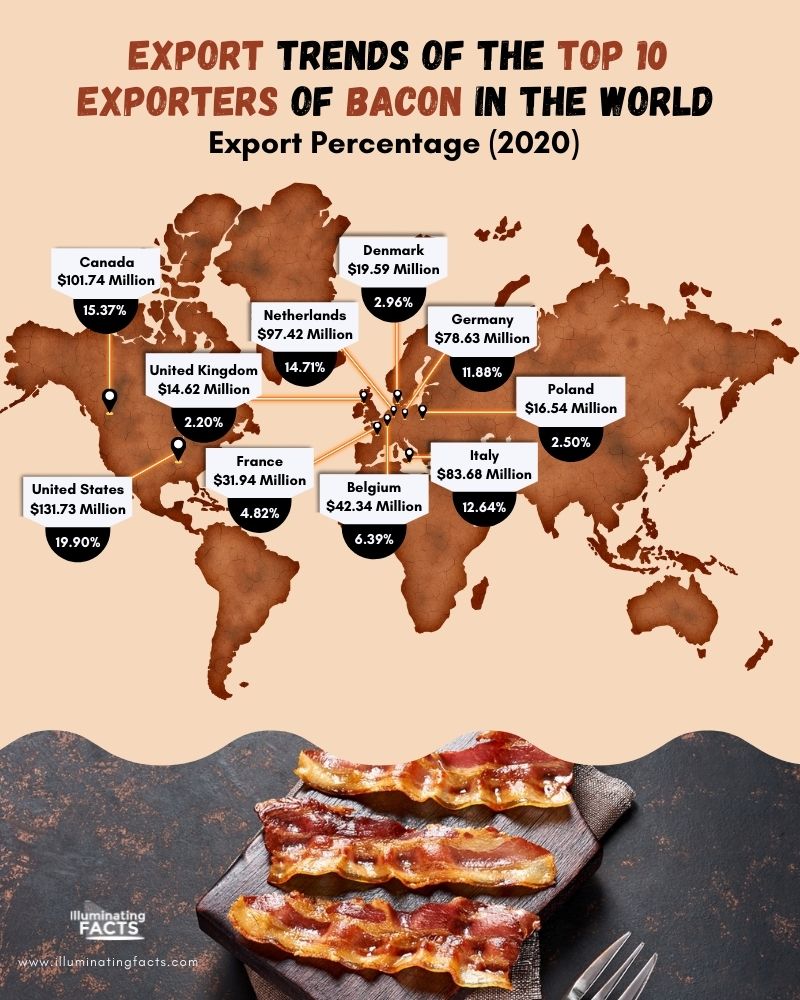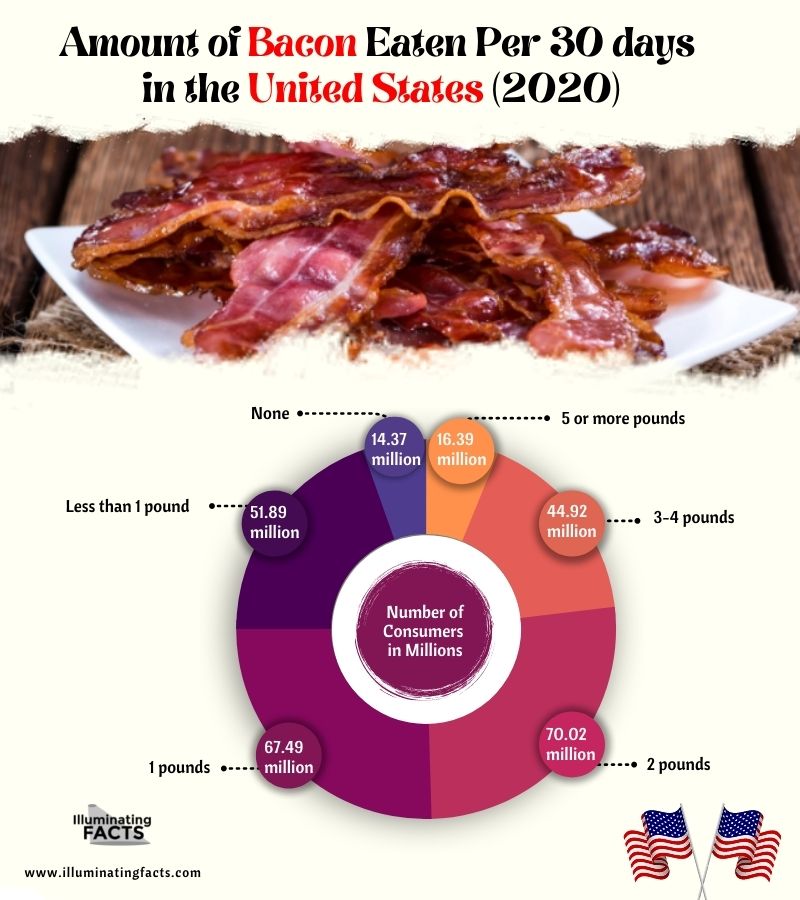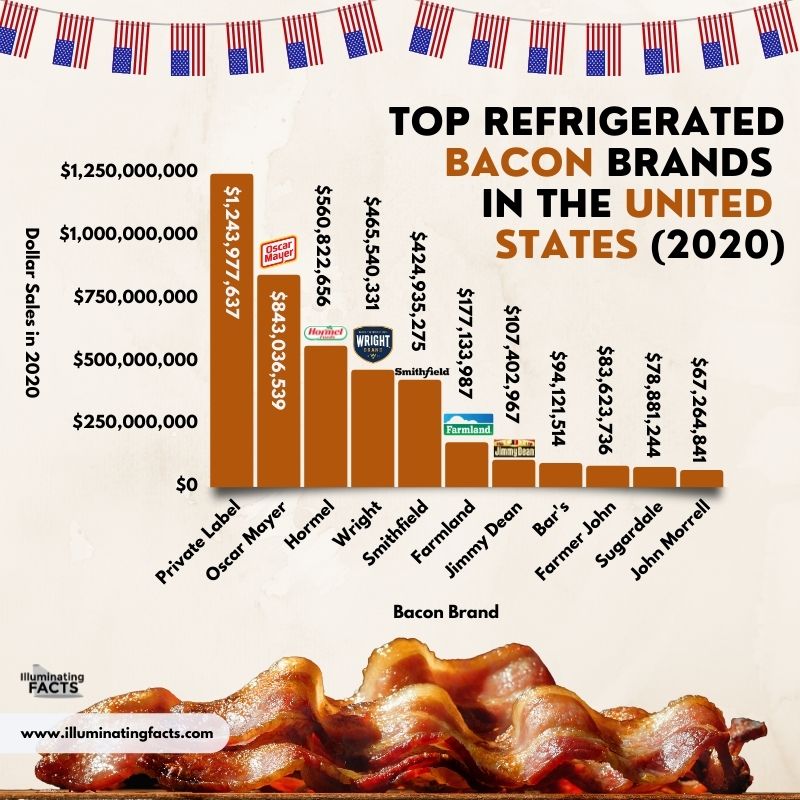Background
When you hear the word “breakfast,” what foods come to mind? There are many different breakfast food items that are popular today, but one of the most favorites is bacon. Its combination of saltiness, crispiness, and fattiness makes a lot of people crave for it, not just in the morning but any time of the day. Just the smell of it can make people get up in the morning and be ready to eat breakfast. In addition to being a popular breakfast food, bacon is also a versatile ingredient. From simple frying to candied and being used as a topping for a doughnut or pizza, it has become an ingredient that is loved by a lot of people.

pork jowls smoked bacon

cooking bacon
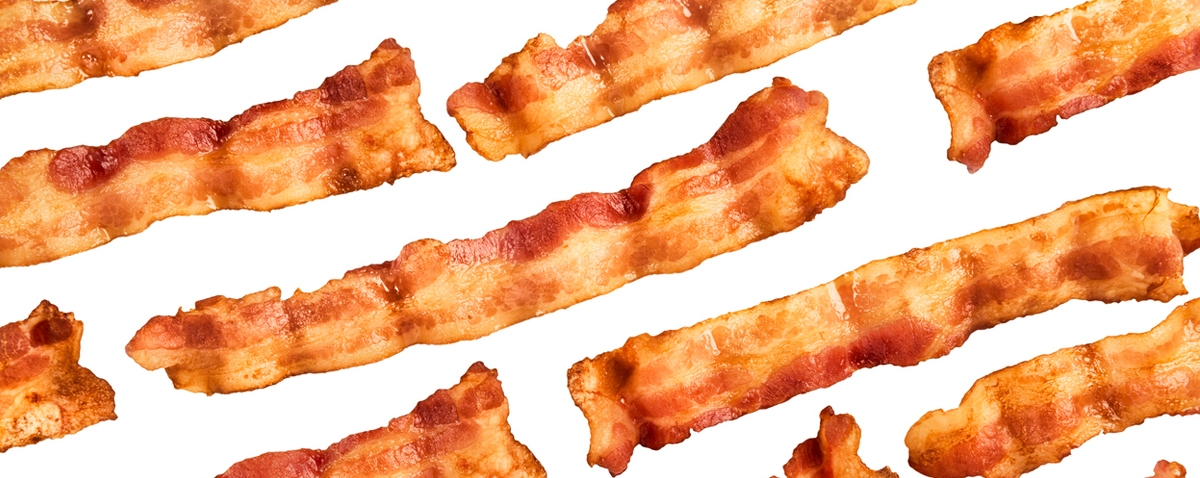
bacon slices
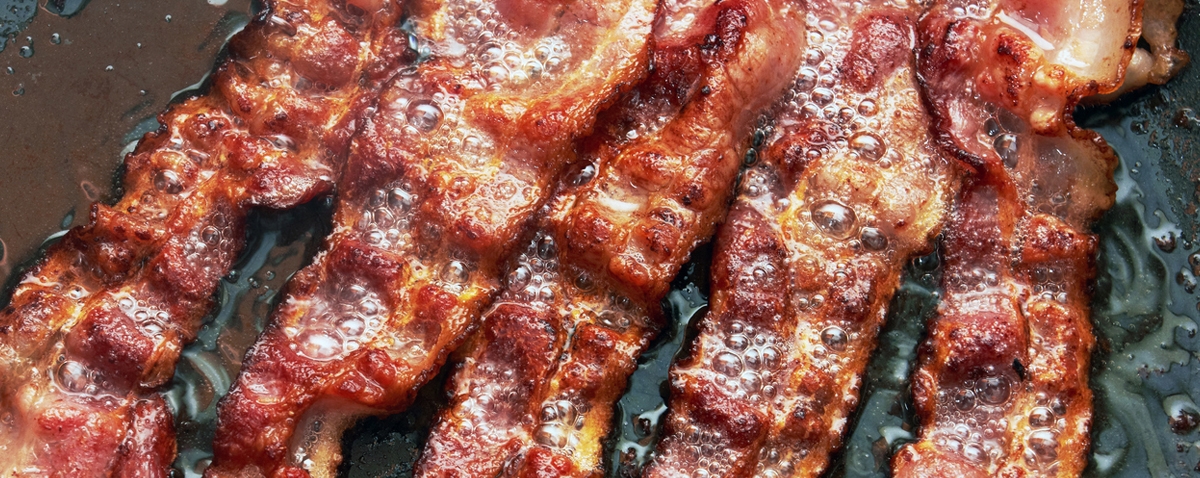
cooking bacon in a frying pan
If you also love bacon and want to learn more about it, you’re in the right place. In this article, we are giving you more information about bacon, including its history, how it is made, its different types, as well as numerical data and statistics about it. Also included are some of the most interesting facts about bacon that might blow your mind. With this, let us start with the fascinating history of bacon.
The Interesting History of Bacon
Bacon is currently among the favorite pork products in the United States, but its history is an international affair. A lot of countries throughout history have cooked slices of salted or cured pork and referred to it as bacon. However, very few nations have elevated bacon into an art form in quite the same way as the British. Therefore, when you research the history of bacon, you need to look first at Great Britain, Anglo-Saxon culinary traditions, and the English language.
Where Did the Word “Bacon” Come From?
Historically, the word “bacon” came from the modern English language. But like many English words, its etymology is a bit more complicated than that. In fact, etymologists are still arguing over its origin.
The tradition of the English bacon dates back to the Saxon era in the 1st millennium AD. Bacon (or bacoun) was a Middle English term that the English used to refer to a traditional cut of pork meat that was unique to Great Britain at the time. What the English were calling bacon at the time pertained to a precise cut of pork belly and pork loin and usually cut from breeds of pig that had been bred precisely to make what we now know as back bacon.
In Old High German, they called bacon “bahho,” which is derived from the Proto-Germanic “bakkon.” In Old Dutch, bacon is called “baken,” while in Old French, it was referred to as “bacun.” When you look back at the history of the word, you can completely understand why there is still an argument over its origin.
However, what is clear is that the rest of the world settled on the English version and spelling of the word.[1]
Bacon in Ancient and Medieval Period
In China, salted pork belly first appeared on dining tables thousands of years ago. The methods of pork curing became popular throughout the Roman Empire, and Anglo-Saxon peasants cooked with bacon fat. The cut that was usually used to make bacon comes from the side or belly of the hog. In modern England, the side of bacon is referred to as a “gammon,” while a thin slice of bacon is called a “rasher.”
Back in the 12th century, a church in the English Town of Great Dunmow assured a side of bacon to whoever married man that could swear before the churchgoers and God that he had not argued with his wife for a year and one day. A man who could “bring home the bacon” was highly looked upon by the community for his patience.[2]
Bacon in the New World
Queen Isabella, along with Christopher Columbus, sent eight pigs to Cuba. However, the National Pork Board credits Hernando de Soto, a Spanish explorer, as the father of the American Pork Industry. In 1539, he transported 13 pigs to the shores of the New World. In three years, his herd had grown to 700. Indigenous people purportedly fell in love with the flavor and willingly accepted pigs and pork products as peace offerings.
A fast-expanding, free-roaming, and unruly swine population by 1653 nearly disenchanted Dutch construction of a wall on Manhattan Island that was meant to keep the British and Indigenous people out of New Amsterdam. Later on, the site became popular as Wall Street. Pigs continuously ran wild in New York City into the 19th century.[2]
Bacon in the Modern Times
Today, many people are conscious of their health. That is why you might expect to find fatty bacon low on the list of favorite foods. However, Americans are eating more pork at the present time than they have in decades. In fact, bacon can single-handedly boost the pork market.
At the present time, Americans eat 70% of their bacon with breakfast. But it is also usually added as an ingredient to sandwiches and hamburgers. They can also be added to dishes like chowders and even to sweets like ice cream and jam. There are even low-sodium varieties today that can be enjoyed by weight watchers in moderation.[2]
How Is Bacon Made?
Bacon is truly one of the world’s most popular breakfast foods. In recent years, it has become something of a cultural phenomenon. But despite the fact that you might have consumed bacon a few hours ago, you might not actually know how exactly it was made. Bacon can be made in two major ways. One is the traditional bacon-making process, while the other is the industrial bacon-making process.
The Traditional Bacon-Making Process
How do you think bacon goes from a cut of fresh pork to a delicious preserved meat? The traditional way of bacon curing is called dry curing. To do this, raw bacon is rubbed with salt and other seasonings, which conveys flavor and cures the meat over a week or two. There are times when sugar is added to the dry rub for additional sweetness. The process is called dry curing, as you no longer need to add any liquid during the curing process.
Usually, after the meat is cured, it is rinsed off, dried, and placed into a smoker for further preservation and flavoring. The smoking process typically occurs at a low heat, which is enough to flavor the bacon without cooking. Also, the type of wood chips used in the smoker can add a specific flavor to the bacon, whether it is applewood, hickory, cherry, and any other type of smoke wood. If the bacon is not smoked, it can also be traditionally hung to air dry in the cold for weeks to months.
Bacon that is dry-cured generally has a stronger flavor compared to wet-cured bacon. This method is the time-honored process for curing bacon. Therefore, traditional types of bacon are mostly dry-cured. However, this process takes more time, making it increasingly rare in the United States at the present time. But there are still artisanal companies that offer traditional dry-cured bacon.[3]
The Industrial Bacon-Making Process
Most of the bacon you can purchase today is cured through wet curing. To do this method, traditional curing ingredients such as sugar, salt, sodium nitrite, and other chemicals or seasonings are mixed to make a brine. The bacon can either be placed in the brine to soak, or the brine can be injected into the meat. The soaking method is called immersion curing. It can take a bit longer compared to the injection method.[3]
Another common process for commercially produced bacon is placing the cured pork in a convection oven. This may take about six hours or more, but it is much faster than smoking, which takes days. When it is heated in an oven rather than smoked, liquid smoke can also be added to give the meat a smoky flavor.[3] Wet cured bacon is high in moisture but lacking in flavor. It is also heavier, making it more expensive. But keep in mind that a higher price tag usually means higher quality.[4]
The Different Types of Bacon
After learning about the two basic processes of making bacon, it is also important to learn about the different varieties of bacon that are available at the butcher, grocery store, or even online. You have already learned about the two main differences, which are dry curing and wet curing. But keep in mind that most bacon that you can buy today is wet-cured, and there are still many different kinds. The varieties and qualities of bacon depend on different factors, from the ingredients in the cure to the method the meat is smoked to the way it has been cut.[4] Below are some of the different types of bacon that you should know about:
Back Bacon
This type of bacon is more common in the United Kingdom and Canada. It comes from the leaner pork loin cut, which gives it a higher meat-to-fat ratio. This is like taking a normal tenderloin or loin roast pork cuts and then curing them like streaky bacon before slicing it finely. Back bacon is a little thicker and has a chewier texture. It is also commonly unsmoked, but there are also smoked versions that you can find. Back bacon is a good option if you are searching for meatier bacon.[5]
Streaky Bacon
This type of bacon is also known as American bacon or side bacon. It is the regular type of bacon that you can buy at pretty much every store. It comes from the fattier belly of the animal and has around one part meat to three parts fat. It is called “streaky bacon” due to its long layers of fat that run parallel to its rind.
Most of the time, streaky bacon is injected with a mixture that contains salt and sodium nitrate, which is also used to cure it. But there are also varieties that are dry-cured or left marinated in a curing solution. After that, the bacon is smoked and sliced thinly. This type of bacon crisps up well when cooked, making it perfect for sandwiches. It is also usually used as an ingredient for different dishes.[5]
Collar Bacon
This is quite a rare type of bacon to find these days, but it was once a staple for a lot of families. It is sourced from the shoulder cut of pork, giving it a darker color and stronger flavor. It is a leaner type of meat than the belly, but it still has some marbling running through it for flavor and moisture.[5]
Smoked or Flavored Bacon
Bacon, as we’ve mentioned earlier, is often smoked with various types of wood chips for extra flavor. One of the most popular choices is hickory due to its sweet but strong smoky flavor. Maple is also popular, and it has a mild and sweet flavor. There are different varieties of smoked bacon in most stores.
In addition to smoking, there are also kinds of bacon with added flavors during the curing process. This is a common way to impart some extra taste without overwhelming the flavor of the bacon itself.[5]
Non-Pork Bacon
While true bacon is made from pork, there are also other types of it that come from other animals. One of the most common non-pork bacon is turkey meat. It was made to be a more lean alternative to bacon. By processing and cutting turkey into slices similar to bacon, curing the meat, and smoking it, it will come out resembling bacon. But it only has a 10% fat content, which means less flavor and a more rubbery texture.
The same process can also be used in making beef bacon and duck bacon. Today, there are also even vegan bacon imitations on the market. While these other non-pork bacon options may come close to the taste of pork bacon, they will not be the same as real bacon.[4]
Jowls
This type of bacon is from cured and smoked pig’s cheeks. Jowl bacon is flavorful and has enough fat for taste and texture. It is a great choice for frying and for eating as a breakfast meat. It is traditionally served with leafy green vegetables. It is also great chopped up as a garnish or used as a binding factor in pork liver sausages.[5]
Lardons
These are small strips of fatty bacon. Lardons are used in different classic French dishes, including quiche Lorraine, bourguignon, and coq au vin. They can also be added to any dish that you think would benefit from their salty flavor and chunky texture. If you find it difficult to find lardons, you can instead buy a slab of bacon and slice it into ¼-inch chunks.[5]
Pancetta
Pancetta is an Italian pork product that is more similar to American-style bacon than Canadian bacon. It is made from pork belly, but it is only cured and not smoked. This type of bacon can be bought sliced extremely thin or diced. It can also add lots of flavor to different dishes. However, the flavor will not be smoky, but just rich and salty with notes of whatever seasonings were used during the curing process.[4]
Speck
This type of bacon originally comes from Europe, particularly from Northern Italy, Switzerland, and Austria. It is quite similar to classic bacon with its thin slice and cured pork cut, but there are also many differences. Speck bacon comes from the leg and not from the belly. This means it has a higher percentage of muscle. Since it is from the boned, opened up, and flattened leg, it has elongated and narrow slices.
Speck bacon is brined, smoked, and air-dried. It is finely sliced and eaten raw. You can wrap this type of bacon around fruits or add it to sandwiches and salads. You can also include it in an antipasti platter.[5]
Pre-Cooked Bacon
For those who do not like the time-consuming and messy processes of cooking bacon, you can also pay extra at the grocery store to get some precooked bacon. This type of bacon is cooked at the production plant before it is packaged. It may seem like a convenient choice for a lot of people, but it does not taste as fresh as a newly cooked bacon. It also does not have any bacon grease, which is used to add flavor to foods.[4]
Health Benefits You Can Get From Bacon
When it comes to eating bacon, we hear a lot of things about the downsides of it. But you should know that there are both pros and cons that come with eating this processed meat. Below are some of the health benefits that you can get from bacon:
Bacon contains healthy fats and saturated fats.
It is true that bacon contains a lot of fat, but 50% of that is monounsaturated and mostly oleic acid, which is the same acid used in making olive oil good for the heart and health. Therefore, the majority of fat that bacon contains is relatively healthy. But you also need to note that a significant portion of bacon’s fat is saturated. The secret is to watch your portion sizes so you won’t overdo your fat intake.
Bacon is high in protein and low in carbohydrates.
If you are on a low-carb and Keto diet, then bacon is good for you. It fits these types of diet as a high-fat, high-protein food source with almost no carbs, at less than one gram per serving.
Bacon is rich in potassium and B-vitamins.
Bacon has some essential micronutrients, such as potassium, which can support bone health, heart health, and muscle strength. In addition to that, it can also help prevent high blood pressure. There are more than 50% of the RDA of two essential minerals in bacon, which are selenium and phosphorus. These are important antioxidants and bone strengtheners. It is also rich in B vitamins, such as vitamin B1, B2, B3, B12, B5, and B6, which can support cellular production, brain function, and energy levels.[6]
Drawbacks of Bacon
However, even when bacon has health benefits, there is a reason why many believe that it is bad for one’s health. Here are some of the drawbacks of eating bacon:
Bacon contains a high amount of sodium.
Since bacon is cured with salt or brine, it is not surprising to know that it is higher in salt compared to other foods. Each serving of bacon has ¼ of the RDA for sodium. Therefore, it is essential to watch portions to keep your salt intake in check. Keep in mind that a diet that is high in salt can raise blood pressure and increase the risk of stomach cancer.
Bacon has nitrates and nitrites.
These are additives that are used in the curing process. It can form carcinogens, which are known cancer-causing agents when exposed to high heat. But there are lots of bacon producers today that began adding antioxidants during the curing process, lowering the nitrate content of the bacon and reducing the risk of ingesting carcinogens.
Too much bacon can lead to certain diseases.
Remember that bacon is processed meat, and some studies have connected a diet high in processed meats with a higher probability of acquiring certain cancers and diseases.[6]
Even though bacon has a few drawbacks, it does not mean you should take it out of your diet. You can still enjoy it as a part of any healthy diet with the help of moderation. Always keep the portion sizes in check, avoid consuming it more than a few times per week, and only use it as a condiment to top your meal instead of serving it as the main course. It is also a good idea to crumble it on a big green salad or add it to grilled vegetables.
Bacon By The Numbers
After learning about the pros and cons of eating bacon and how you can incorporate it into your diet in a healthier way, there are more things you need to know about this popular processed food. In this part, we are giving you some of the important numbers and statistical data about bacon, including its nutritional facts, global import, global export, brands, and consumption.
Bacon Nutrition Facts
Below are the bacon nutrition facts per five slices of cooked bacon:
By looking at the nutritional facts of bacon, we can say that it is not bad for you, as the media usually makes out. However, it is also not the most nutritious food in the world. It also tastes delicious, which is enough for many people to enjoy it.[7]
Global Import of Bacon
Take a look at the graph below to see the import trends of the top 10 importers of bacon in the world from 2013 to 2020:
According to Tridge, the top importer of bacon in the world in 2020 was the United States, earning $101.21 million. It was followed by the United Kingdom with $78.44 million. Other countries that belong to the top ten importers of bacon in the world are France, Denmark, Belgium, Canada, Mexico, Germany, Italy, and the Netherlands.[8]
Global Export of Bacon
The graph below shows the export trends of the top 10 bacon exporters in the world from 2013 to 2020:
Based on the research done by Tridge, the United States was the top exporter of bacon in the world in 2020, with a percentage of 19.9. It has earned $131.73 million from bacon exports in the said year. It is followed by Canada with $101.74 million. Other countries on the list include the Netherlands, Italy, Germany, Belgium, France, Denmark, Poland, and the United Kingdom.[9]
Amount of Bacon Consumed Within 30 Days in the United States
Below is a statistic that shows the amount of bacon eaten in a month in the United States in 2020:
The data above was calculated by Statista based on the United States census data and Simmons National Consumer Survey or NHCS. Based on their research, 16.39 million Americans consumed 5 or more pounds of bacon in a month in 2020. The majority of them, which is 70.02 million, stated that they ate 2 pounds of bacon in the last 30 days in 2020.[10]
The Top Brands of Refrigerated Bacon in the U.S. in 2020
Below is a graph that shows the dollar sales of the top refrigerated brands of bacon in the United States in 2020:
The data is based on the Information Resources Inc., which is the total U.S. Multi-Outlet Time: Latest 52 Weeks Ending June 14, 2020. Based on the research, the top refrigerated bacon brand in the U.S. in 2020 was from a private label. It earned $1,243,977,637 in 2020. Some of the known brands on the list include Oscar Mayer, Hormel, Wright, Smithfield, and Farmland.[11]
Interesting Facts About Bacon
If you are looking into learning more about bacon, here are some of the most interesting facts about this processed food that might blow your mind:
- According to research, there are cognitive benefits of eating bacon. In a study done at the University of North Carolina, they found out that choline, a micronutrient in bacon, can help in healthy brain development in unborn babies.
- Did you know that bacon is environmentally friendly? It’s because bacon and pork have a much smaller carbon footprint compared to beef. Based on a study, growing beef requires 28 times more land and 11 times more water compared to pork and bacon.
- Bacon today is 86% cheaper than it was a hundred years ago. Back in 1919, the nominal price of bacon was $0.53 per pound, while the average nominal wages were $0.25 an hour.
- Bacon was first served in China thousands of years ago. It was around 1500 BC when salted pork belly first appeared in China.
- Americans eat an average of 18 pounds of bacon per year.
- Did you know that three slices of bacon have fewer calories compared to a can of pop? Three average slices of bacon have 120 calories, while a 12-ounce can of Pepsi has 150 calories.
- One serving of bacon is equal to about one-fifth of the recommended daily fat, or 20% of the daily recommended fat intake.
- Around 70% of bacon is consumed at breakfast, making it a very popular breakfast food.
- Many people want to make bacon the national food of America, based on a survey done by Smithfield Foods in 2014.
- Did you know that there is a bacon camp in the United States? Each year, Camp Bacon is held in Ann Arbor, Michigan. It enables bacon enthusiasts to listen to speakers, try cooking classes, and learn a lot of things about bacon.
- Romans called bacon “petaso.” They made it by boiling salted pig shoulder with figs and seasoning it with pepper sauces.
- The word bacon refers to the back of the pig that supplied the meat.
- During World War II, bacon was used to make explosives.
- There is also a church of bacon, which has more than 25,000 members under the commandment “Praise Bacon.” It’s quite crazy, but it’s true.
- There was an alarm clock called the Wake ‘n Bacon that was planned a few years back. It promised to wake up people to fresh-cooked bacon. However, it never made it past the prototype phase.
Conclusion
Bacon is indeed among the most popular foods, not just in the United States but as well as in many parts of the world. It is something that most of us think about when we hear the word “breakfast.” It is also a delicious ingredient that you can add to many dishes, such as salads, pasta, soups, and sandwiches. It is amazing to learn that the bacon most of us love has been in existence for thousands of years. It is very likely that it will continue to exist and evolve in the years to come. We hope this article helped you learn more about the amazing bacon industry.
References
[1] Bule, G. (2020). History of bacon. History Of Bacon. Retrieved February 16, 2022, from https://englishbreakfastsociety.com/history-of-bacon.html
[2] Filippone, P. T. (2021, July 23). Through the ages, bacon inspires marital harmony and culinary devotion. The Spruce Eats. Retrieved February 16, 2022, from https://www.thespruceeats.com/history-of-bacon-1807563
[3] S. Clyde Weaver, E. (2022, January 31). How is bacon made? What is Bacon & Where Does It Come from. S Clyde Weaver. Retrieved February 16, 2022, from https://sclydeweaver.com/blog/how-is-bacon-made/
[4] Heasman, C. (2020, February 26). This is how bacon is really made. Mashed.com. Retrieved February 16, 2022, from https://www.mashed.com/190925/this-is-how-bacon-is-really-made/
[5] Clements, J. (2021, October 18). 9 types of bacon to try before you die. Smoked BBQ Source. Retrieved February 16, 2022, from https://www.smokedbbqsource.com/types-of-bacon/
[6] James, M. (2021). Is Bacon Healthy? health benefits, drawbacks, and delicious bacon alternatives. TofuBud. Retrieved February 16, 2022, from https://tofubud.com/blogs/tips/is-bacon-healthy
[7] Joseph, M. (2019, July 3). Is bacon really bad for you? 9 things to consider. Nutrition Advance. Retrieved February 16, 2022, from https://www.nutritionadvance.com/is-bacon-bad-for-you/
[8] Tridge, E. (2021). Bacon global import and top importing countries. Tridge. Retrieved February 16, 2022, from https://www.tridge.com/intelligences/bacon/import
[9] Tridge, E. (2021). Bacon global import and top importing countries. Tridge. Retrieved February 16, 2022, from https://www.tridge.com/intelligences/bacon/export
[10] Statista Research Department. (2021, July 2). U.S.: Amount of Bacon Eaten 2020. Statista. Retrieved February 16, 2022, from https://www.statista.com/statistics/279780/us-households-amount-of-bacon-eaten-within-30-days/
[11] Fuhrman, E. (2020, August 31). 2020 bacon report: Bacon-buying Bonanza. The National Provisioner RSS. Retrieved February 16, 2022, from https://www.provisioneronline.com/articles/109847-bacon-report-bacon-buying-bonanza
[12] Miltimore, J. (2020, January 3). 15 economic, historical, and Health Facts about bacon: Jon Miltimore. FEE Freeman Article. Retrieved February 16, 2022, from https://fee.org/articles/15-economic-historical-and-health-facts-about-bacon/
[13] Wells, J. (2019, December 30). 12 savory facts about bacon. Mental Floss. Retrieved February 16, 2022, from https://www.mentalfloss.com/article/85427/12-savory-facts-about-bacon

